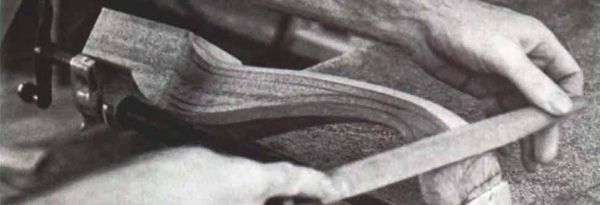
Synopsis: Philip C. Lowe reviews the history of the cabriole leg and its foot styles and explains how to make a Queen Anne style leg, which terminates in a spoon foot, also called a club or dutch foot. Instead of using a lathe, he shows how to make it using a bandsaw (or bowsaw), spokeshave, rasp, and file. The pad diameter of the foot should be about half the width of the blank, which should be solid wood, not laminate. He describes how to make a template from the first leg you make, and then determine grain orientation relative to one another. Step-by-step instructions and detailed drawings and photographs cover every detail.
From Fine Woodworking #42
Cabriole legs, all characterized by the cyma or S-curve, have taken various styles. The cabriole seems to have evolved from the ancient practice of shaping the legs of furniture after those of beasts, and so in Egyptian furniture you see cabriole legs ending in rather literal animal feet. The Chinese favored more abstract renditions. Chippendale, who borrowed many of his ideas from the Chinese, popularized the ball-andclaw foot, along with carved acanthus leaves decorating the knee. To my eye, the sparest, most pleasing form of the cabriole is the Queen Anne, which terminates in a spoon foot, also called a dub or dutch foot.
The leg involves methodical shaping with hand tools. Traditionally, slipper and trifid feet were also hand-shaped. The spoon foot, however, was usually lathe-turned. But there are those who don’t have a lathe, and even for those who do, the lathe has a disadvantage: it necessitates carrying the circular perimeter of the foot all the way around, which interrupts the flow of the line down the back of the ankle. Here is how to design, lay out, cut and shape a Queen Anne cabriole, with bandsaw (or bowsaw), spokeshave, rasp and file.
Consider first the rough thickness of the lumber you will use. Solid lumber is best, as laminate lines will interrupt the wood’s figure and look offensive when the leg is cut. The most suitable thicknesses for cabriole legs are 10/4, 12/4 and 16/4, depending on the length of the leg and the size of the piece of furniture it will support. I always figure the working thickness of rough stock, after it is planed, to be ¼in. less than it is nominally. For a typical chair or low table, 12/4 stock, which will yield 2¾in. of working thickness, is suitable.
You’ll need a full-size drawing of the leg, including the post block, knee, transition piece (also called the knee block), ankle, and foot, which is made up of the toe and pad (figure 1, facing page). On a piece of paper, draw a rectangle the length of the leg and ¼in. smaller than the rough thickness of your stock. Within this rectangle draw the post block first, its length equal to the width of the rail it will join, or, if the leg adjoins a case, the width of the front, back or end. The width of the post block depends on the thickness of the tenons it will receive, as well as on the desired curvature of the knee. For 12/4 stock, a 1¾-in. square post block is common, readily accommodating ¼-in. thick tenons in ¾-in. thick stock.
For the full article, download the PDF below:
Fine Woodworking Recommended Products

Starrett 12-in. combination square

Drafting Tools

Stanley Powerlock 16-ft. tape measure





















Log in or create an account to post a comment.
Sign up Log in